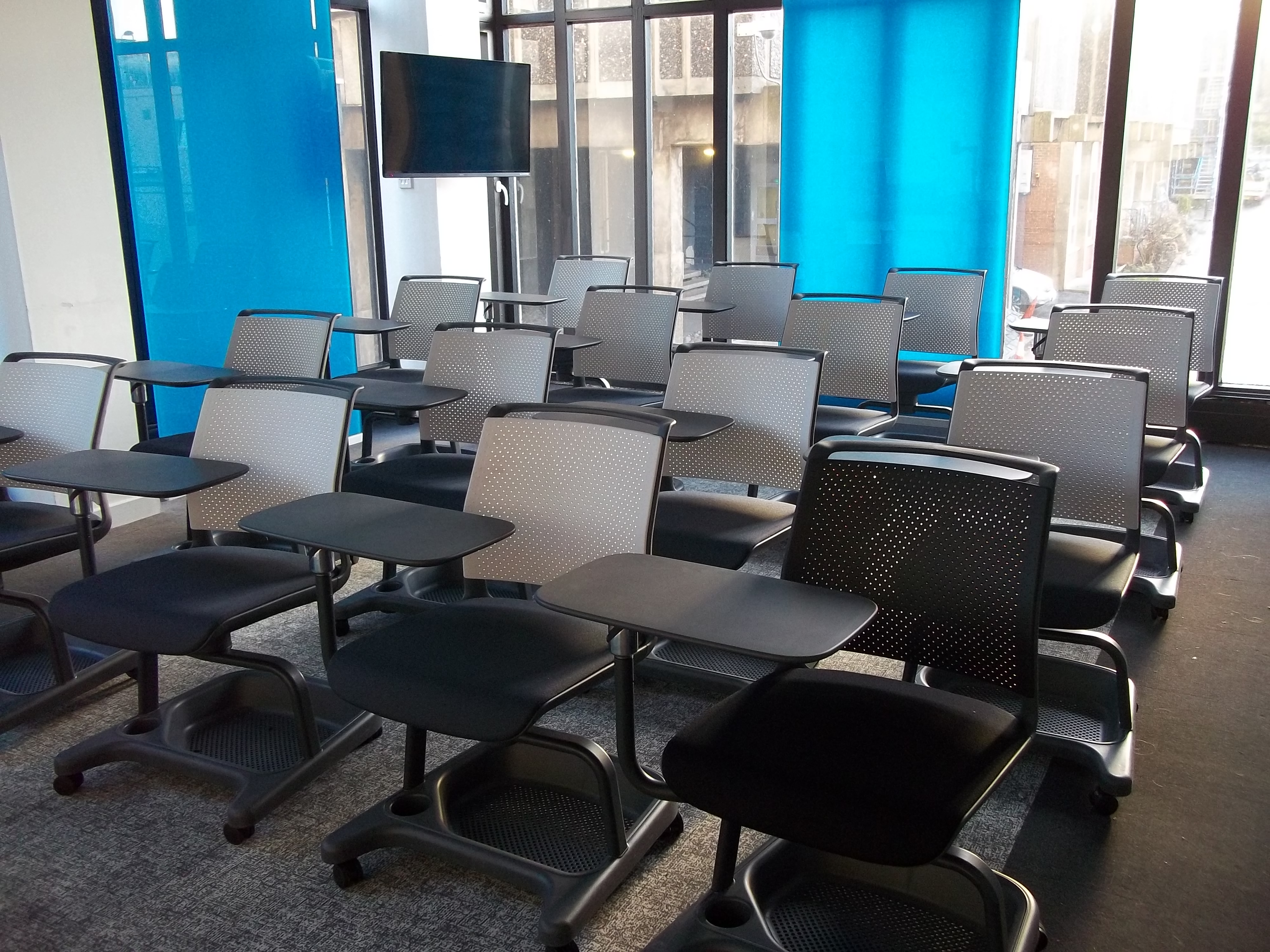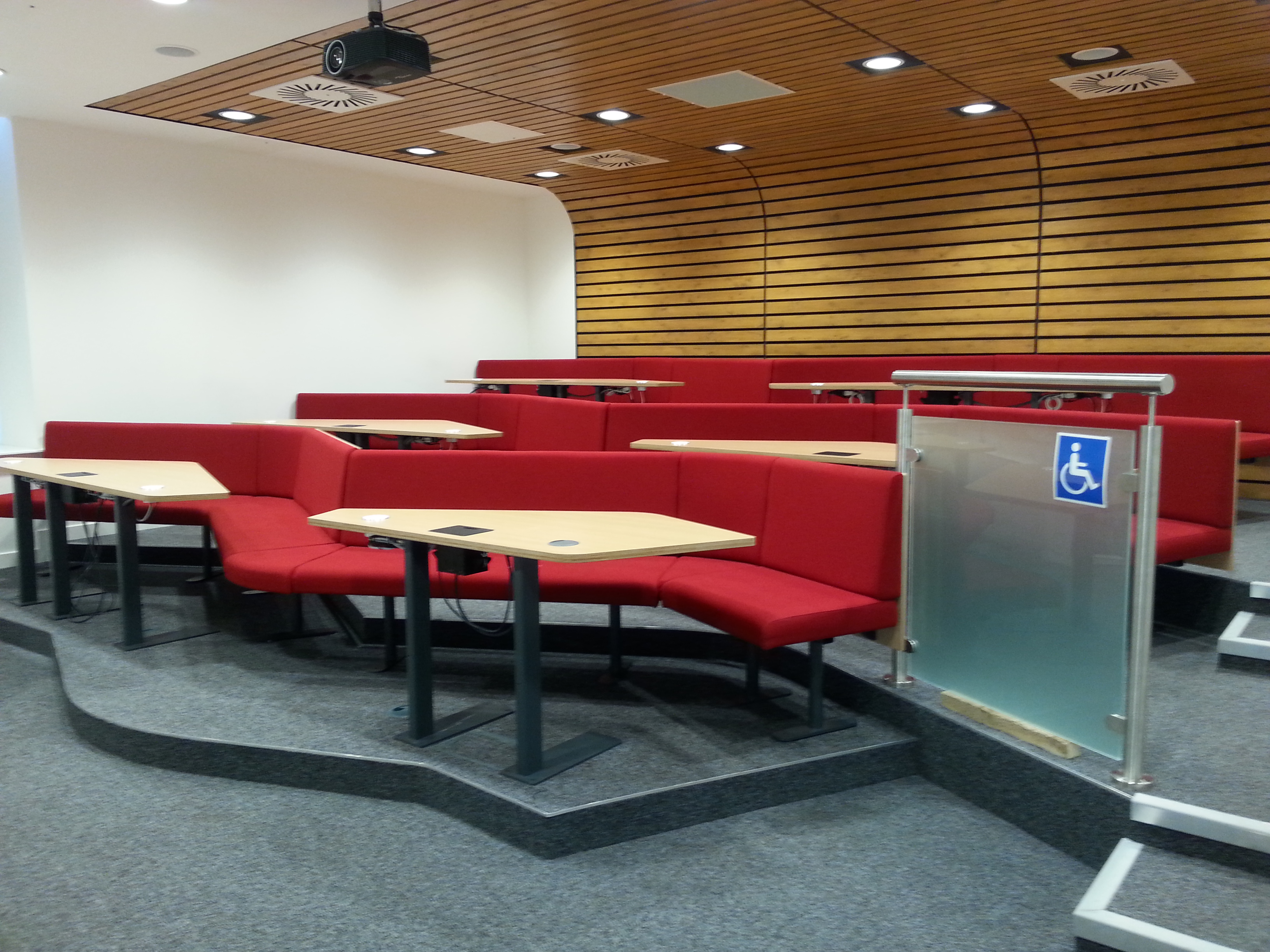Last changed
24 Feb 2017 ............... Length about 2,000 words (17,000 bytes).
(Document started on 16 Oct 2016.)
This is a WWW document maintained by
Steve Draper, installed at http://www.psy.gla.ac.uk/~steve/localed/dalek.html.
You may copy it.
How to refer to it.
Web site logical path:
[www.psy.gla.ac.uk]
[~steve]
[localed]
[this page]
The new dalek/TEAL/Active rooms
By
Steve Draper,
Department of Psychology,
University of Glasgow.
Ths page collects notes on the new (2016-7) rooms in GU being trialled with new
layouts, new techno, promoting more interactivity.
Layouts

Wolfson seminar room 2
60
|

Wolfson seminar room 3
60
|

ASB 901
12
|

ASB 902
15
|

ASB 903
12
|

ASB 904
15
|

StAnd 202
30
|

StAnd 227
60
|

StAnd 230
30
|

BoydOrr 213
15
|

James Watt South room 361 (J7)
34
|

Joseph Black room C407
50
|
Tips, facts about the rooms
- The projector controls etc. look bewildering at first, and may well hold up
the first time room user for 10 mins, but in fact are more similar than at
first appears to the current equipment in other lecture theatres (LTs).
- But many connector slots are unlabelled: e.g. many USB ports, which
however have quite different purposes from each other.
- In the dalek rooms with individually movable chairs for students, it
probably takes staff facilitation and student experience for a week or two, to
make students feel it's both OK and primarily their job to move the chairs
around to suit them when they come in. And just as in LTs, it will probably
all work much more easily when the room is no more than two thirds capacity
full.
- Staff need to bring in many mains extension cords if students are to be
able to connect their devices to mains power.
- HDMI connector cables are apparently a trap. No students will have them
(but would like to take them) because of cost AND many devices don't have HDMI
but a kind of mini-HDMI slot [or actually, there are 5 types of HDMI connector
defined: having one kind will not service the other kinds?]. So it may be
unlikely that students can in fact connect their devices to projectors and
screens in the room without connectors being provided. These connector
slots are often non-standard or not provided at all on personal devices
because there is no physical space for them in small devices.
- These rooms seem to have 2 (sets of) screens, individually usable i.e.
you can rely on projecting 2 different things at once.
People
Working group
- Moira Fischbacher-Smith
(Assistant Vice-Principal (Learning & Teaching))
- Brian Husband (AV-IT)
- Karen Lee (Timetabling)
- Eleanor Magennis (Estates & Buildings)
- Kevin O'Dell (MVLS)
- Don Spaeth (Dean of L&T, college of Arts)
- Matthew Williamson (L&TC, director)
Others
Cathy Bovill (L&TC, academic development unit)
URLs, videos
References (from a TEAL presentation)
-
Bligh, D.A. (1972) What's the use of lectures? Harmondsworth, Penguin.
- Chickering, A.W. and Gamson, Z.F. (1987) Seven principles for good practice
in undergraduate education. AAHE Bulletin March, pp.3-7
http://eric.ed.gov/?id=ED282491
- Chiu, P.H.P. and Cheng, S.H. (2016) Effects of active learning classrooms on
student learning: a two-year empirical investigation on student perceptions and
academic performance. Higher Education Research and Development Onlinefirst:
http://www.tandfonline.com/doi/full/10.1080/07294360.2016.1196475?scroll=top&needAccess=true
- Cuseo, J. (2007) The empirical case against large class size:
adverse effects on the teaching, learning and retention of first-year students.
The Journal of Faculty Development 21 (1) 5-21.
- Gibbs, G. (2010) Dimensions of Quality. York: Higher Education Academy.
heacademy
- Huxham, M. (2005) Learning in lectures. Do interactive windows help? Active
Learning in Higher Education 6 (1) 17-31.
- Kuh, G. & Hu, S. (2001) The effects of student-faculty interaction in the
1990s. The Review of Higher Education 24 (3) 309-332.
- Michael, J. (2006) Where's the evidence that active learning works? Advanced
Physiology Education 30 159-167.
The independent issues underlying these rooms
There are 3 quite different issues here:
- Active learning, regardless of technology e.g. having group
discussions.
Many pedagogical techniques and designs for active learning are very old, and
effective. They interact, though, with what is afforded by room furniture, and
by new technology.
Examples include:
- Room capacity and layout.
- Even with seating unfriendly to discussion (e.g. fixed seats all facing
the front) group discussions are quite easy to arrange if the room is used
only to about 25% capacity, or up to say 50%. The groups can space themselves
so they don't interrupt each other too much; and climbing over seats to reach
the middle is OK.
- These problems are not solved in the current "dalek" rooms
(e.g Wolfson sem-3) with individually movable chairs, when used with
as many chairs as there would be with fixed chairs. Staff report that if the
room is near capacity, then latecomers cannot get from the door to the empty
chairs: just as in a lecture theatre. And presumably, even if all seated,
then groups will be too close to each other to hear their own group without
inteference from talk from other groups.
- Wider row spacing. Jim Boyle at Strathclyde (MechEng.) had a 100 seat
lecture theatre full (room M406, James Weir Building); but the seats were
arranged in groups of 4 in a shallow arc to allow discussion between 4 sitting
in a row. It has a slightly wider row spacing allowing the same students to
sit together each time, regardless of who arrives first.
- Large round tables (e.g. seating 12) are bad a) because half the people
at each table cannot face the front if there is any exposition from the front;
b) because those on one side are nearer the next table than to those opposite
them, so they cannot hear the others in their own group.
- Failure to build rooms suited for discussion is an old failing in HEIs:
as witness a book chapter on this from 50 years ago.
Institutions build a few big rooms; not many small rooms, despite what is
required for better teaching and learning.
(?Architecture pattern book?).
- Small staff offices prevent group discussions in offices. Given that
students have similar timetables, the times they are available for tutorials
are similar, so having a few group rooms that staff can book doesn't work
well. Open plan offices for staff (as at Salford) prevent even 1:1 meetings
with students.
- Technology for electronic sharing.
- EVS /
YACRS
- 2cc type active learning compared to doing written feedback
from staff.
- Teacher has not one but several devices up front and in use.
Yacrs already tends to promote this by putting into separate windows
what is projected,
what the students will see on their devices
a teacher-only control screen, that may show things such as how many
have voted, ...
- Sharing datasets and calculations. E.g. Simon Bates' design and
use of a lab for first year physics.
And sharing datasets ...
Issues limiting progress
Progress and productivity enhancements for learning are limited by
the interaction of these key factors:
Web site logical path:
[www.psy.gla.ac.uk]
[~steve]
[localed]
[this page]
[Top of this page]



